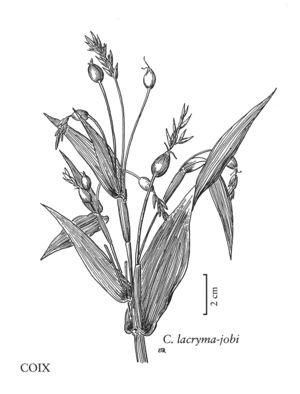Difference between revisions of "Coix lacryma-jobi"
FNA>Volume Importer |
FNA>Volume Importer |
||
| Line 1: | Line 1: | ||
{{Treatment/ID | {{Treatment/ID | ||
|accepted_name=Coix lacryma-jobi | |accepted_name=Coix lacryma-jobi | ||
| − | |accepted_authority= | + | |accepted_authority= |
|publications= | |publications= | ||
|common_names=Job's-tears | |common_names=Job's-tears | ||
| Line 16: | Line 16: | ||
-->{{Treatment/Body | -->{{Treatment/Body | ||
| − | |discussion=<p>Coix lacryma-jobi is a tall, maize-like plant. In North America, it is usually grown as an ornamental, but it has become established at scattered locations in the Flora region. The involucres, which can be used as beads, may be white, blue, pink, straw, gray, brown, or black, with the color being distributed evenly, irregularly, or in stripes. Cultivars with easily removed involucres are grown for food and beverage, especially in Asia.</p> | + | |discussion=<p><i>Coix lacryma-jobi</i> is a tall, maize-like plant. In North America, it is usually grown as an ornamental, but it has become established at scattered locations in the Flora region. The involucres, which can be used as beads, may be white, blue, pink, straw, gray, brown, or black, with the color being distributed evenly, irregularly, or in stripes. Cultivars with easily removed involucres are grown for food and beverage, especially in Asia.</p> |
|tables= | |tables= | ||
|references= | |references= | ||
| Line 25: | Line 25: | ||
-->{{#Taxon: | -->{{#Taxon: | ||
name=Coix lacryma-jobi | name=Coix lacryma-jobi | ||
| − | + | |authority= | |
| − | |authority= | ||
|rank=species | |rank=species | ||
|parent rank=genus | |parent rank=genus | ||
| Line 32: | Line 31: | ||
|basionyms= | |basionyms= | ||
|family=Poaceae | |family=Poaceae | ||
| + | |illustrator=Linda A. Vorobik;Cindy Roché | ||
| + | |illustration copyright=Utah State University | ||
|reference=None | |reference=None | ||
|publication title= | |publication title= | ||
|publication year= | |publication year= | ||
|special status= | |special status= | ||
| − | |source xml=https:// | + | |source xml=https://jpend@bitbucket.org/aafc-mbb/fna-data-curation.git/src/f50eec43f223ca0e34566be0b046453a0960e173/coarse_grained_fna_xml/V25/V25_1671.xml |
|subfamily=Poaceae subfam. Panicoideae | |subfamily=Poaceae subfam. Panicoideae | ||
|tribe=Poaceae tribe Andropogoneae | |tribe=Poaceae tribe Andropogoneae | ||
Revision as of 21:35, 16 December 2019
Plants annual or perennial. Culms to 3 m. Leaves mostly cauline, evidently distichous; blades to 75 cm long, 1.5-6 cm wide. Involucres usually 8-12 mm, varying in color. Lower glumes of functional pistillate spikelets 6-10 mm, hyaline below, 5-7-veined, with a 1-3 mm coriaceous beak. Staminate rames 10-35 mm, with 3-25 spikelet pairs, disarticulating at maturity; spikelets 5-9 mm, dorsally compressed; glumes exceeding the florets, with 15+ veins; lower glumes elliptic to obovate, somewhat asymmetrical, margins folded inward, apices obtuse; upper glumes lanceolate to narrowly elliptic, keels often winged, apices acute; upper lemmas 5-8 mm, hyaline, elliptic to ovate, 3-veined; upper paleas similar but 2-veined; anthers 3-6 mm. 2n = 20.
Discussion
Coix lacryma-jobi is a tall, maize-like plant. In North America, it is usually grown as an ornamental, but it has become established at scattered locations in the Flora region. The involucres, which can be used as beads, may be white, blue, pink, straw, gray, brown, or black, with the color being distributed evenly, irregularly, or in stripes. Cultivars with easily removed involucres are grown for food and beverage, especially in Asia.
Selected References
None.
